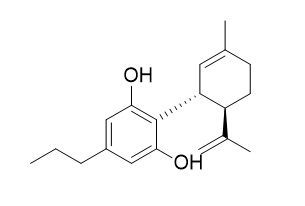Cannabidivarin
Cannabidivarin is a potent inhibitor against gamma 2 subunit of GABAA receptors by forming a maximum of number of interactions with the docking score (-5.3), it may serve as a novel drug with definite control over childhood absence epilepsy. It is also an effective anticonvulsant in a broad range of seizure models.
Inquire / Order:
manager@chemfaces.com
Technical Inquiries:
service@chemfaces.com
Tel:
+86-27-84237783
Fax:
+86-27-84254680
Address:
1 Building, No. 83, CheCheng Rd., Wuhan Economic and Technological Development Zone, Wuhan, Hubei 430056, PRC
Providing storage is as stated on the product vial and the vial is kept tightly sealed, the product can be stored for up to
24 months(2-8C).
Wherever possible, you should prepare and use solutions on the same day. However, if you need to make up stock solutions in advance, we recommend that you store the solution as aliquots in tightly sealed vials at -20C. Generally, these will be useable for up to two weeks. Before use, and prior to opening the vial we recommend that you allow your product to equilibrate to room temperature for at least 1 hour.
Need more advice on solubility, usage and handling? Please email to: service@chemfaces.com
The packaging of the product may have turned upside down during transportation, resulting in the natural compounds adhering to the neck or cap of the vial. take the vial out of its packaging and gently shake to let the compounds fall to the bottom of the vial. for liquid products, centrifuge at 200-500 RPM to gather the liquid at the bottom of the vial. try to avoid loss or contamination during handling.
J Appl Biol Chem.2024, 67:47,337-343.
Int J Mol Sci.2018, 19(9):E2681
Agronomy 2021, 11(3),502.
Oncol Rep.2021, 46(2):166.
Front Pharmacol.2024, 15:1455805.
Front Pharmacol.2022, 13:870553.
Phytomedicine.2022, 110:154597.
Front Plant Sci.2021, 12:673337.
Food Funct.2020, 11(2):1322-1333.
Acta Pharm Sin B.2024, 14(4):1772-1786.
Related and Featured Products
Br J Pharmacol. 2012 Dec;167(8):1629-42.
Cannabidivarin is anticonvulsant in mouse and rat.[Pubmed:
22970845 ]
Phytocannabinoids in Cannabis sativa have diverse pharmacological targets extending beyond cannabinoid receptors and several exert notable anticonvulsant effects. For the first time, we investigated the anticonvulsant profile of the phytocannabinoid Cannabidivarin (CBDV) in vitro and in in vivo seizure models.
METHODS AND RESULTS:
The effect of CBDV (1-100 μM) on epileptiform local field potentials (LFPs) induced in rat hippocampal brain slices by 4-aminopyridine (4-AP) application or Mg(2+) -free conditions was assessed by in vitro multi-electrode array recordings. Additionally, the anticonvulsant profile of CBDV (50-200 mg·kg(-1) ) in vivo was investigated in four rodent seizure models: maximal electroshock (mES) and audiogenic seizures in mice, and pentylenetetrazole (PTZ) and pilocarpine-induced seizures in rats. The effects of CBDV in combination with commonly used antiepileptic drugs on rat seizures were investigated. Finally, the motor side effect profile of CBDV was investigated using static beam and grip strength assays.
CBDV significantly attenuated status epilepticus-like epileptiform LFPs induced by 4-AP and Mg(2+) -free conditions. CBDV had significant anticonvulsant effects on the mES (≥100 mg·kg(-1) ), audiogenic (≥50 mg·kg(-1) ) and PTZ-induced seizures (≥100 mg·kg(-1) ). CBDV (200 mg·kg(-1) ) alone had no effect against pilocarpine-induced seizures, but significantly attenuated these seizures when administered with valproate or phenobarbital at this dose. CBDV had no effect on motor function.
CONCLUSIONS:
These results indicate that CBDV is an effective anticonvulsant in a broad range of seizure models. Also it did not significantly affect normal motor function and, therefore, merits further investigation as a novel anti-epileptic in chronic epilepsy models.
International Journal of Pharmacy & Pharmaceutical Sciences, 2014, 6(5):430-433.
In silico screening of phytochemical compounds targeting childhood absence epilepsy (CAE).[Reference:
WebLink]
Childhood absence epilepsy (CAE) is the most frequent pediatric epilepsy syndrome. Since, the mechanism of the disease is not well defined, evidence of successful treatment for CAE is not found till date. Hence, an attempt is made to identify novel plant based compounds which may be effective against Pediatric epilepsy syndrome, to meet this demand for newer drugs with minimal side effects.
METHODS AND RESULTS:
We performed a virtual screening of different synthetic compounds/current medications namely ethosuximide, valproic acid, lamotrigine, carbamazepine and vigabatrin were compared against plant derivatives. Cannabidivarin is a potent inhibitor against gamma 2 subunit of GABAA receptors by forming a maximum of number of interactions with the docking score (-5.3).
CONCLUSIONS:
The plant compound Cannabidivarin (CBDV) may serve as a novel drug with definite control over childhood absence epilepsy.



